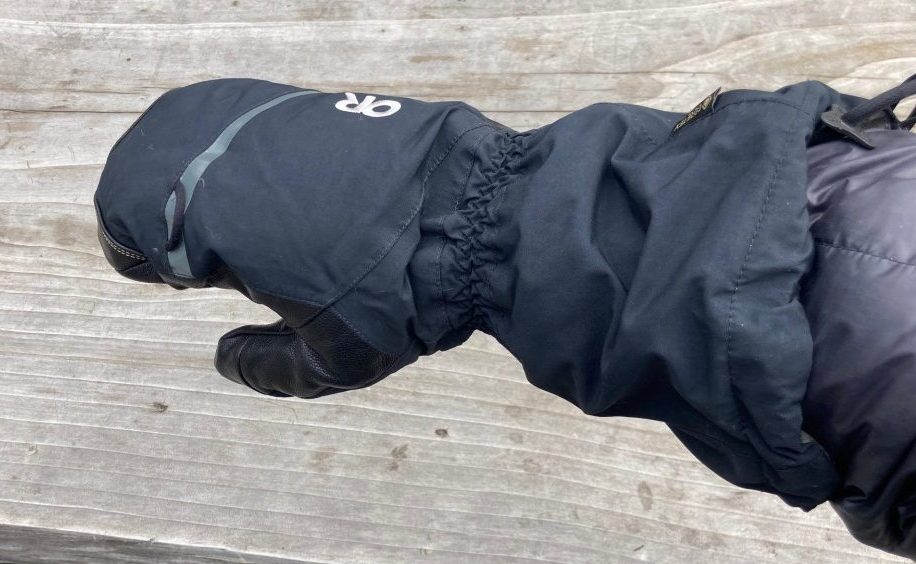
The OR Alti Mitt: a gauntlet style mitt providing this skier much needed warmth and weatherproofness.
Here’s an idea of the severity of my recent nauseating screaming barfies. Imagine a relatively warm day in late February ice climbing in Hyalite Canyon. (Thanks to Sam Hennesey’s motivation, we climbed in ski boots.) It had been something like 25 years since I’d climbed there—nostalgia brought on boldness.
The older child led up. He spotted me some relatively inexpensive but nimble Japanese fishing gloves for the ax-swinging. These Showa gloves were thin, generally, and thinly insulated yet waterproof. I’ve spent time in the Bristol Bay salmon industry- these gloves would be keepers up there. Showas are the rage, evidently, among ice climbers.
By mid-climb my digits were numbing.
Twenty feet from the top, nausea hit. Walking past the belay, I swear, my vision speckled with a Pink Floyd laser light show of colors. I stumbled to a flat spot and buckled over. My child, recognizing my utter weakness, took control by draping a puffy over me. I grunted, fighting back the finger-thaw-induced heaving. Yet, when children say things like “you’ll be OK, dad,” that’s a parenting apogee.
About ten minutes later, feeling rather wrecked and shelled from the thawing, I was ready to go.
In a third dimension where the screaming barfies and OR Alti Mitts cage fight, I’d take the mitts in the long run. But, let’s face it, even the thought of screaming barfies makes me shudder.
That day, 404 grams of Outdoor Research Alti Gore-Tex Mitts were stuffed in my pack. The mittens are oh-so-warm, we’ll get to that, but not so nimble, more on that too, so I chose not to ice climb in them. But thank you, material engineers and design gurus at OR. Just knowing those big mitts were in the pack, no matter how pathetic I may have appeared writhing there in Hyalite, were worth a few degrees of warming comfort. That’s too many words to express this: my hands quickly get cold, and I always pack mittens in the ski pack.
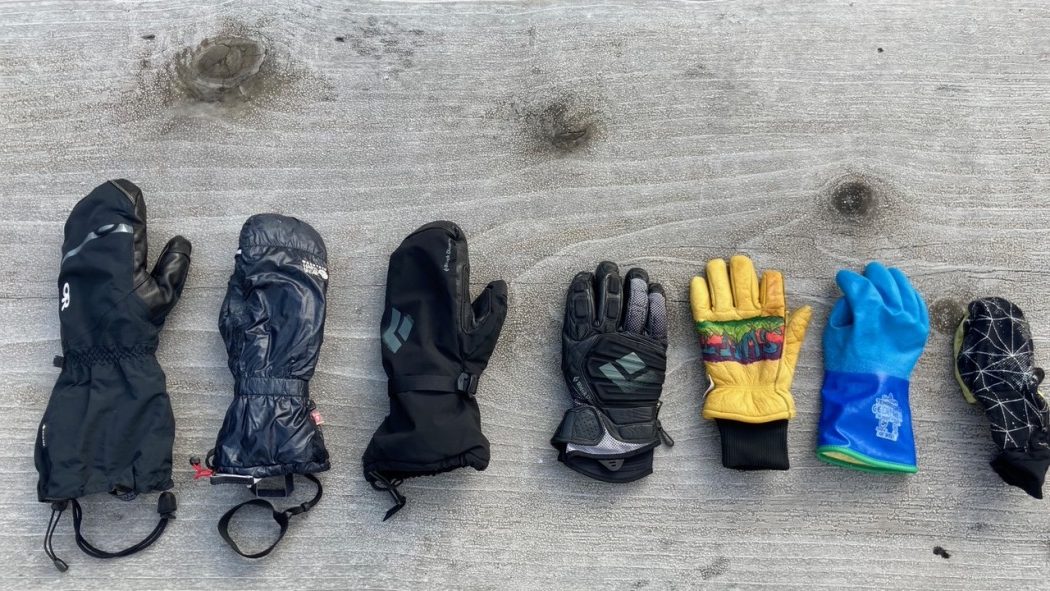
The full spectrum of my hand warming arsenal. From left to right: the OR Alti Mitt, Mountain Hardware Compressor Mitt, can’t recall the name of this BD mitt but liner not removable, BD ski glove that looks sweet for moto-cross, basic leather insulated glove, Showa waterproof glove, and a beloved Nathan glove/mitt. On last Saturday’s ski, I had five of the available seven options available. Overkill? Maybe.
Outdoor Research says the Alti Mitts are solid for ascending 8000m peaks. I’ve no experience with that, so I cannot speak to that claim’s validity. It is a mitt constructed from a 2.5L Gore-Tex outer and is really a mitten nested within a mitten. So from the start, there was a hint of promise for warm and dry digits.
The Inner Mitt
The inner mitt, which is not waterproof on its own, but is water-resistant, can be pulled out easily (or reinserted easily) and worn as a stand-alone mitten. I’ve found it suitable for quick fixes like buckling boots or affixing/ripping skins in cold weather. (We had a cold snap recently.) The inner mitt’s outer fabric is a 40D ripstop nylon; the inner face is a soft pile. Leather protects the finger and thumb areas. A small interior pouch for a hand warmer sits atop the hand, and a velcro closure can secure the opening around the wrist. The inner mitt is also insulated with 340 g/m2 (according to OR) of PrimaLoft Gold.

The inner mitt, red, and outer mitt, black shown here. This mitt within a mitt system provides warmth and the option for greater dexterity when using only the inner mitt.
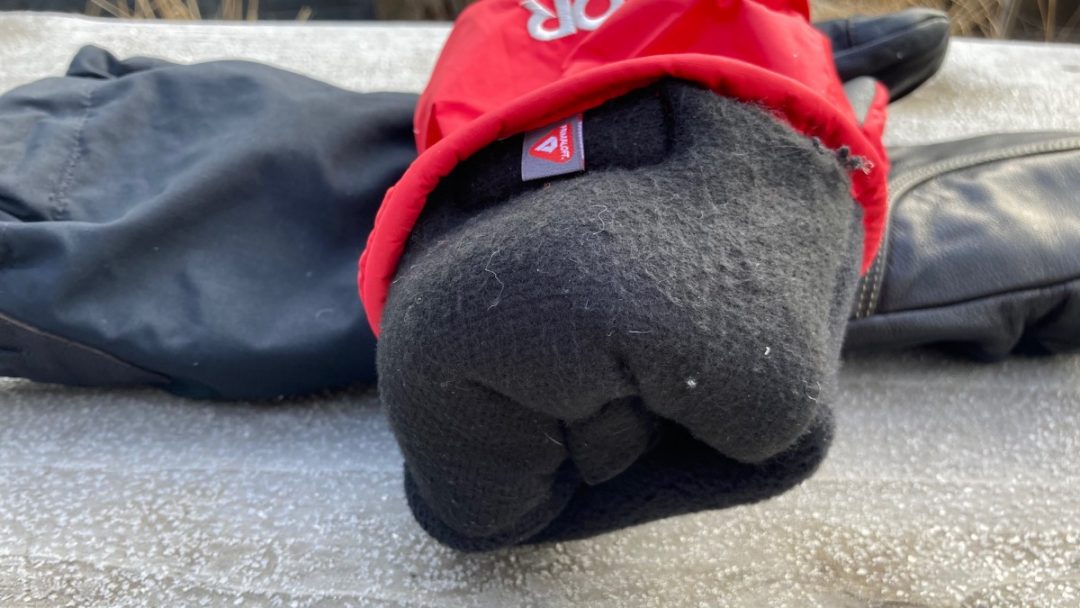
Here we see the inner lining of the inner mitt pulled out. It too is pile lined. The inner mitt also features PrimLoft Gold insulation.
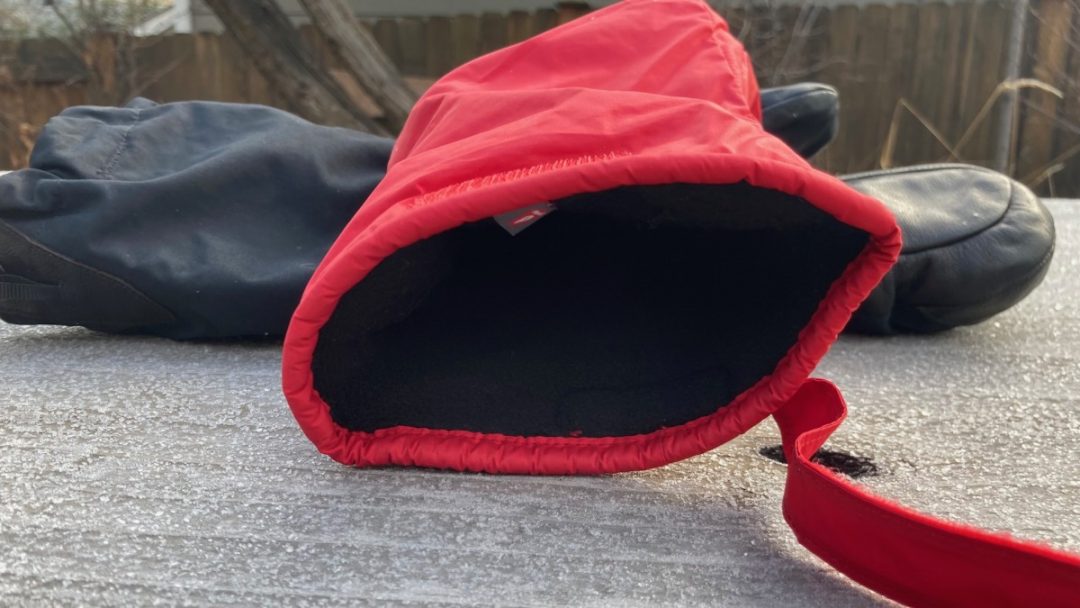
The inner mitt showing the velcro tab for protecing the wrist area when worn without the outer mitt.
The Outer Mitt
The outer shell portion of the Alti Mitt is not simply a nylon/Gore-Tex shell; there’s some PrimaLoft insulation stuffed in there for good measure (OR says 170 g/m2 of PrimaLoft Gold). This portion is fleece-lined, whereas the gauntlet features a nylon lining in the event snow sneaks inside—there’s no pile to wet out. The palm and thumb are reinforced with leather for durability. Other features include a clip-in loop for stowing the mitts on a harness or pack, another sewn loop near the cuff to make getting the mitt on your hand a breeze, a closure on the gauntlet to help keep snow out, and an adjustable leash so dropping the mitt when removing it is all but eliminated.
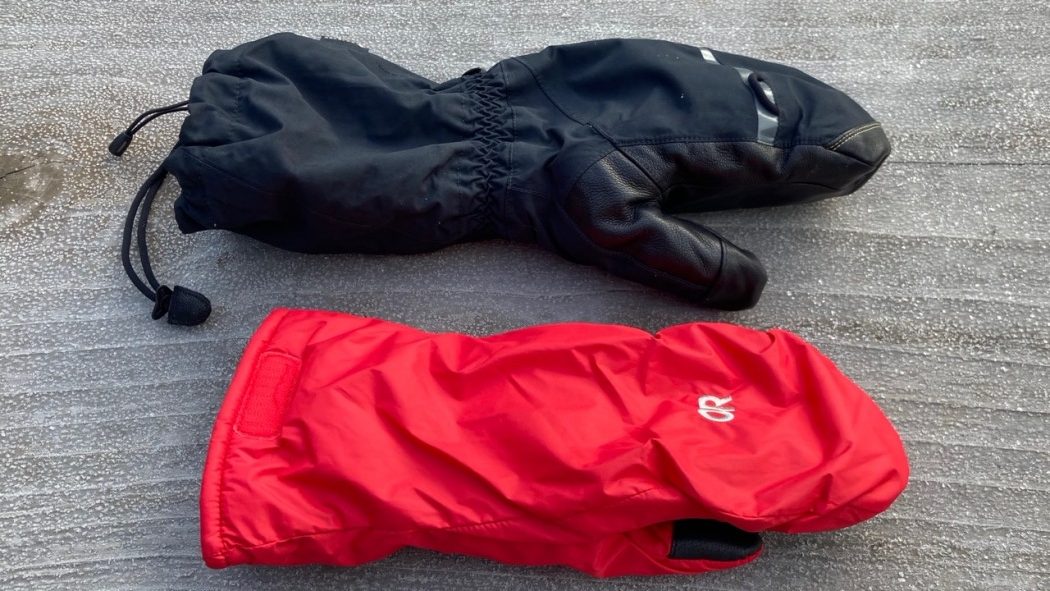
A topside view of the inner and outer mitt.
OR calls the body’s construction a “pre-curved box construction.” That means the full mitt has a gentle natural feeling curve when your hand is inserted and at rest. I’m in size large, which provides ample room for my digits to move inside the mitt and have some qualified dexterity. The Alti is a beefy mitt, but I can grip a ski pole. Do I have the sensitivity/dexterity wearing the mitts that I do say wearing a leather ski glove? Nope. But from my personal experience, that’s to be expected, yet I’m able to ski fine, poles in hand, with these burly mitts. If it’s just cold, not brrrr cold, the inner mitt serves as a great option to keep hands warm, but not too warm, while skinning.

Here we note the clip-in loop and leather reinforcements of the outer mitt.
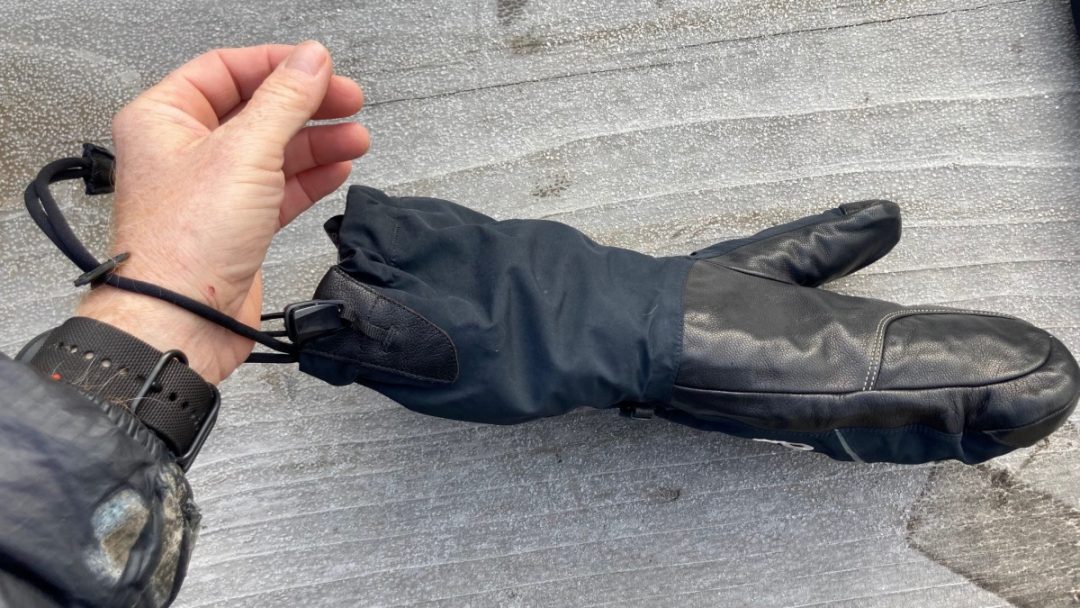
A removable cinch strap on the Altis allows for safe keeping when a tasks requires one to take off the mitt.
Wearing the full mitts, you’ll not be lighting a stove quickly or ripping and folding skins; those tasks, however, are doable wearing only the inner mitt.
In testing the Alti Mitt, I looked for two primary attributes, warmth and waterproofness. So far, the mitts are plenty warm.
I’m often bad about using mittens for cold prevention. My rule for wearing mittens when backcountry skiing is likely flawed: I wait until my hands are chilled before donning them to warm up. In springtime, ironically, I’m better at cold hand prevention. I often use mittens when cramponing and axing up steep slopes as my hands are likely to be intermittently immersed in snow or touching ice. So far, this winter, as a means to rewarm chilled hands, the Altis have been golden.
The Alti’s weather-proofness was a whole other level I had not expected. I’ve used the Mountain Hardware Compressor Mitt for rewarming and general cold-related emergencies for the past several years. This also is a Gore-Tex mitt with less overall insulation and warmth than the Alti, yet greater dexterity.
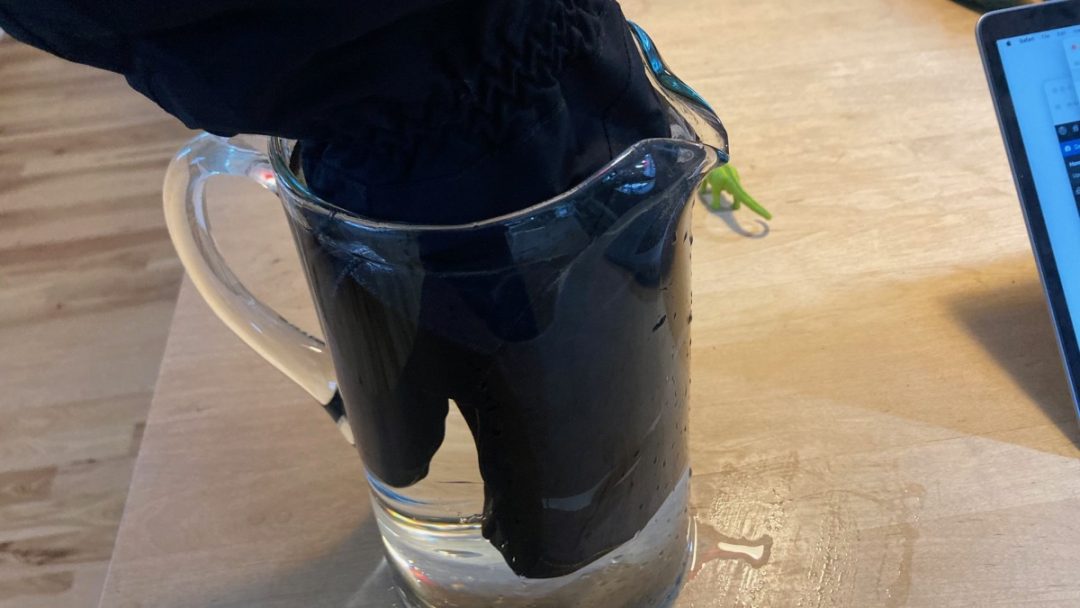
Submersion test for the OR Alti Mitts. These are a Gore Tex mitt with taped seams. After five minutes submerged, my hand was perfectly dry.
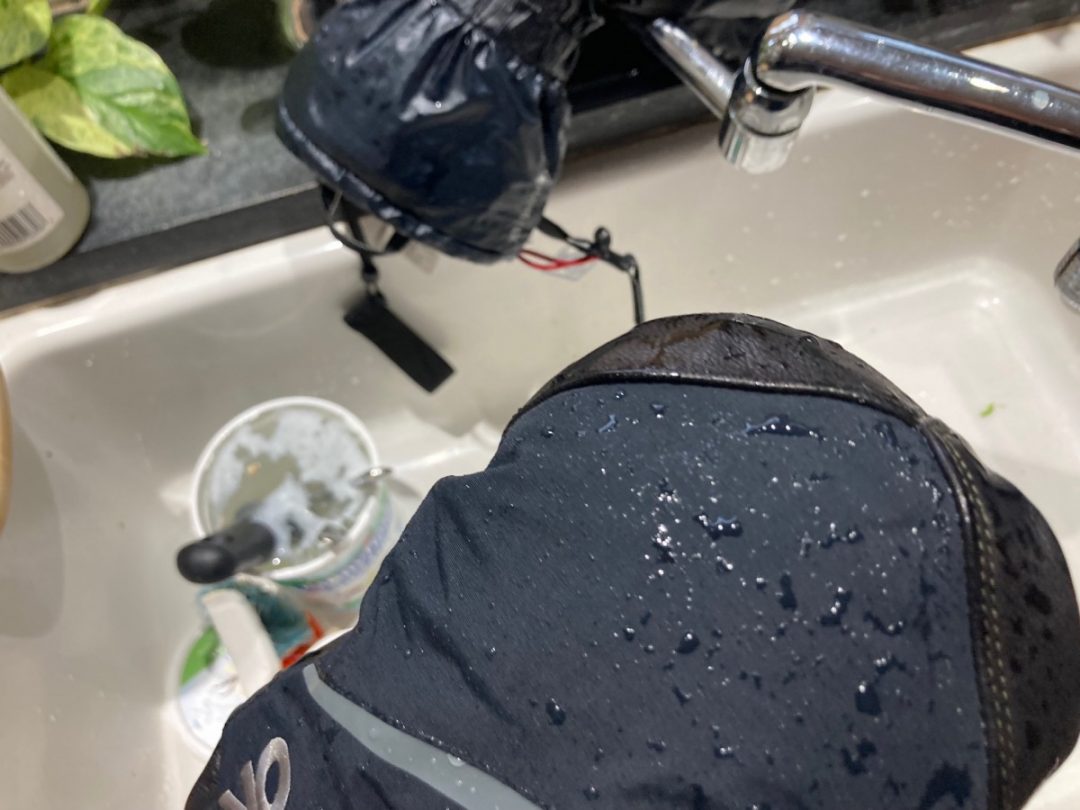
Moments after the submersion test, the Alti’s fabric had shed most of the water.
For comparison, I submerged each mitten in a vase of water. My hands were damp after 20 seconds and soaked before a minute elapsed wearing the Compressor. I submerged the Alti Mitt in the vase and stopped the test after five minutes—the fabric repelled the water and the interior was perfectly dry. The Alti’s Gore-Tex fabric and taped seams were up to its touted moisture barrier job.
There are some differing opinions out there. Here’s one sample from the OR website:
“The insulation is very thin with these mitts and my hands freeze in them. I live in Northern Ontario where the temperature is -30 Celsius for months at a time. Really disappointing that they couldn’t add more insulation, they are OK until about -15 at best, anything colder and my hands freeze. I nearly get frostbite in -25 and below. If you live in a truly cold place, I’d suggest getting snowmobile mitts, GKS or something. These are completely useless for where I live, I can’t imagine using them for mountaineering for the “roof of the world”, they are very thin and lightweight, and certainly inadequate for northern locations. The price is ridiculously high for what you get. I’ll never buy anything from Outdoor Research again.”
Negative 30 Celsius is no joke; that’s -22 Fahrenheit! For me, time to stay indoors. Or, say, up in the Arctic, maybe time to remain tent bound on an expedition. That’s cold. But, I would not describe these mittens as thin or lightweight in the realm of mitts for the winter backcountry. In fact, as someone who babies their hands when it comes to cold, the Altis are thick and, as expected, heavier, 202g/mitt.
The warmth of the Altis is on par with the Black Diamond Super Light Mitts and the BD Absolute Mitt, both options for an Alaskan or deep Canada trip, maybe Northern Ontario aside. (I have limited experience with these mittens, but they are in the same class.)
I’ve been packing and using the Altis since early December. So far, the outer fabric, leather palm, and kevlar stitching are in good shape. I’m digging the Alti both for its full mitt protection and the option to use the inner mitt for higher dexterity tasks. It’s like two mittens with distinct strengths in one warm package.
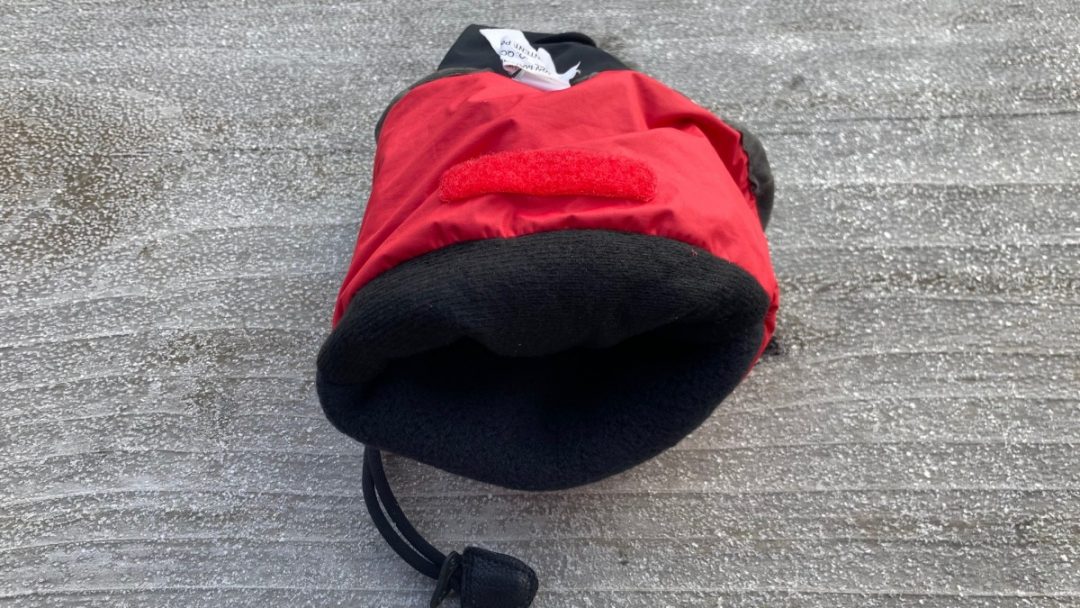
This is outer mitt with the inner lining pulled through to show the pile liner.
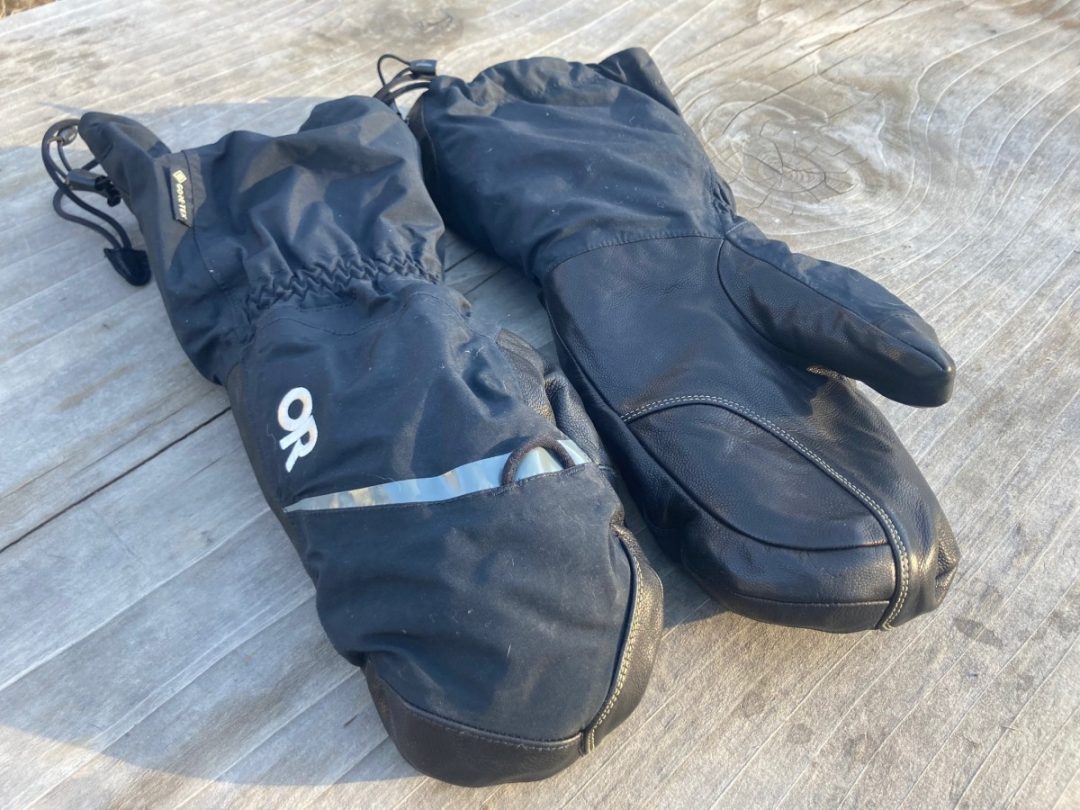
The Anti Mitt, for me, is also a solid warm hand insurance policy when stashed in the pack.
You’ll pay for this type of protection—roughly $199.00 for a pair. (These things change, but you may be able to find them on sale.) That’s on par with the BD Super Light, and roughly $70 cheaper than BD’s Absolute mitt. (Both the Super Light and Absolute mitt use Gore-Tex fabric.) The Alti Mitt also comes in a similar women’s version.
Weight: 202g/mitt size large. For comparison, BD’s stats claim the Super Light is 142g/mitt, while the Absolute Mitt is 212g/mitt [Size M].
But, the review isn’t over for those who want to get granular. During my Internet gear-sleuthing, I came across a study on the effectiveness of gloves and mittens in Antarctica. Here’s a link to “Glove and mitten protection in extreme cold weather: an Antarctic study.” This study looked at a cross-spectrum of gloves and mittens, some battery heated, some with liners, some without, to determine which option kept the digits within a “safe ‘Winter’ Comfort Zone.”
The glove/mitten options tested were limited. “In this study, the supply of gloves and mittens was limited to a convenience sample of gear available among team members at McMurdo Station and Scott Base,” reads the study. You guessed it; the study is not a full-blown examination of the mittens or gloves available to us for winter backcountry use. Yet, the study includes the OR Alti Mitt. Of the nine iterations of mittens to meet the safe temp comfort zone and pain threshold, the OR Altis, Marmot’s 8000 Meter mitt, along with a generic mystery mitt were the only three non-heated options to pass. Although several of the heated mitt options passed the test with the batteries switched off.
In a third dimension where the screaming barfies and OR Alti Mitts cage fight, I’d take the mitts in the long run. But, let’s face it, even the thought of screaming barfies makes me shudder.
For those who choose to dig into the data:

Shop for the Outdoor Research Alti Mitt.
Jason Albert comes to WildSnow from Bend, Oregon. After growing up on the East Coast, he migrated from Montana to Colorado and settled in Oregon. Simple pleasures are quiet and long days touring. His gray hair might stem from his first Grand Traverse in 2000 when rented leather boots and 210cm skis were not the speed weapons he had hoped for. Jason survived the transition from free-heel kool-aid drinker to faster and lighter (think AT), and safer, are better.
